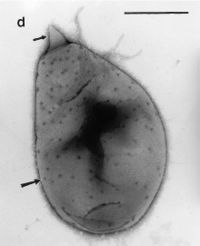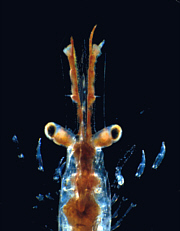Planctomyces
A Microbial Biorealm page on the genus Planctomyces

Classification
Higher order taxa:
Bacteria; Planctomycetes; Planctomycetacia; Planctomycetales; Planctomycetaceae
Species:
Planctomyces brasiliensis, P. limnophilus, P. maris, P. sp.
|
NCBI: Taxonomy Genome |
Description and Significance
Planctomyces is a marine bacterium that can be found in various habitats around the world. Planctomycetes in general are intriguing because they are the only free living bacteria known to lack peptidoglycan in their cell walls. In many cases their DNA is surrounded by a membrane similar to a eukaryotic "nuclear membrane," but evolved independently.
Genome Structure
Although no Planctomyces bacteria have been sequenced, a physical map of the circular chromosome of Planctomyces limnophilus DSM 3776 was made using pulsed-field gel electrophoresis techniques. From this it was deduced that the size of the genome is 5.204 Mb as determined by restriction enzyme digests - this is significantly larger than the 4.2 Mb that was determined by thermal renaturation methods. Relatively large genomes are thought to be necessary for adaptation to changing conditions in nutrient-poor or fluctuation environments; since the P. limnophilus was isolated from a eutrophic lake, which could be considered a demanding environment, it has been suggested that a number of the genes in its genome assist in environment adaptation (Ward-Rainey et al. 1996).
Cell Structure and Metabolism


Planctomyces generally have a spherical shape and uniform crateriform structure distribution all over the cell surface. Their cell walls lack peptidoglycan; they are instead stabilized by the protein sacculus with disulfide bonds. Planctomyces, as well as the rest of the planctomycetes, go through budding reproduction. Many planctomycetes conduct "anammox" metabolism, a process in which ammonia is oxidized by nitrate to nitrogen gas, yielding energy.
Ecology
Planctomyces brasiliensis was originally isolated from a hypersaline lake in Brazil, but it, as well as other species of Planctomyces, can be found in many different types of geographical regions and habitats. It has been found in freshwater, saltwater, acid bog water, cattle manure, garbage dumps, and rice paddies. Though they tend to flourish in the summer and fall back in the winter. This is partially due to the need for Planctomyces need for algae, which is not as prevelant in winter. Planctomyces and other planctomycetes are also often encountered in tissue cultures of aquatic invertebrates. Several studies of planctomycetes have included isolating Planctomyces, Pirellula, Gemmata, or related organisms from giant tiger prawn (Penaeus monodon) samples. Both the samples of the healthy prawn postlarvae and the samples of the postlarvae infected with monodon baculovirus (making them more susceptible to diseases and bacterial infections) had planctomycete populations. Planctomycetes may exist free living or associated with invertebrates in marine habitats rich with organic nutrients (Fuerst et al. 1997).
